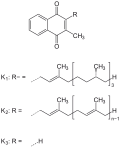(thiamine) Vitamin B2 (riboflavin) Vitamin B3 (niacin) Vitamin B5 (pantothenic acid) Vitamin B6 (pyridoxine) Vitamin B7 (biotin) Vitamin B9 (folic acid...
68 KB (6,397 words) - 21:53, 2 November 2024
Vitamin C (also known as ascorbic acid and ascorbate) is a water-soluble vitamin found in citrus and other fruits, berries and vegetables. It is also a...
145 KB (15,194 words) - 02:59, 11 November 2024
B vitamins are a class of water-soluble vitamins that play important roles in cell metabolism and synthesis of red blood cells. They are a chemically diverse...
43 KB (2,802 words) - 19:28, 11 November 2024
compounds within this group are vitamin D3 (cholecalciferol) and vitamin D2 (ergocalciferol). The primary natural source of vitamin D is the synthesis of cholecalciferol...
163 KB (17,774 words) - 22:30, 2 November 2024
Vitamin B12, also known as cobalamin, is a water-soluble vitamin involved in metabolism. It is one of eight B vitamins. It is required by animals, which...
112 KB (12,263 words) - 21:52, 11 November 2024
Vitamin K is a family of structurally similar, fat-soluble vitamers found in foods and marketed as dietary supplements. The human body requires vitamin K...
69 KB (7,757 words) - 14:42, 24 September 2024
Vitamin A is a fat-soluble vitamin that is an essential nutrient. The term "vitamin A" encompasses a group of chemically related organic compounds that...
108 KB (12,499 words) - 06:04, 23 October 2024
Vitamin B6 is one of the B vitamins, and is an essential nutrient for humans. The term essential nutrient refers to a group of six chemically similar...
62 KB (7,074 words) - 19:18, 7 November 2024
The term Vitamin E refers to a group of eight molecular-structure related compounds that include four tocopherols and four tocotrienols. The tocopherols...
88 KB (10,447 words) - 22:57, 13 November 2024
Vitamin D deficiency or hypovitaminosis D is a vitamin D level that is below normal. It most commonly occurs in people when they have inadequate exposure...
69 KB (7,912 words) - 16:25, 2 November 2024








